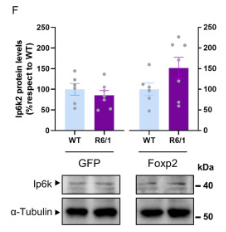IP6K2 Antibody - #DF8669
| Product: | IP6K2 Antibody |
| Catalog: | DF8669 |
| Description: | Rabbit polyclonal antibody to IP6K2 |
| Application: | WB IF/ICC |
| Cited expt.: | WB |
| Reactivity: | Human, Mouse, Rat |
| Prediction: | Pig, Bovine, Horse, Sheep, Rabbit, Dog, Chicken, Xenopus |
| Mol.Wt.: | 49 kDa; 49kD(Calculated). |
| Uniprot: | Q9UHH9 |
| RRID: | AB_2841873 |
Related Downloads
Protocols
Product Info
*The optimal dilutions should be determined by the end user. For optimal experimental results, antibody reuse is not recommended.
*Tips:
WB: For western blot detection of denatured protein samples. IHC: For immunohistochemical detection of paraffin sections (IHC-p) or frozen sections (IHC-f) of tissue samples. IF/ICC: For immunofluorescence detection of cell samples. ELISA(peptide): For ELISA detection of antigenic peptide.
Cite Format: Affinity Biosciences Cat# DF8669, RRID:AB_2841873.
Fold/Unfold
ATP 1D myo inositol hexakisphosphate phosphotransferase; IHPK 2; IHPK2; Inositol hexakisphosphate kinase 2; InsP6 kinase 2; Ip6k2; IP6K2_HUMAN; KIAA0263; OTTHUMP00000164824; P(i) uptake stimulator; P(i)-uptake stimulator; Pi uptake stimulator; PiUS;
Immunogens
A synthesized peptide derived from human IP6K2, corresponding to a region within the internal amino acids.
- Q9UHH9 IP6K2_HUMAN:
- Protein BLAST With
- NCBI/
- ExPASy/
- Uniprot
MSPAFRAMDVEPRAKGVLLEPFVHQVGGHSCVLRFNETTLCKPLVPREHQFYETLPAEMRKFTPQYKGVVSVRFEEDEDRNLCLIAYPLKGDHGIVDIVDNSDCEPKSKLLRWTTNKKHHVLETEKTPKDWVRQHRKEEKMKSHKLEEEFEWLKKSEVLYYTVEKKGNISSQLKHYNPWSMKCHQQQLQRMKENAKHRNQYKFILLENLTSRYEVPCVLDLKMGTRQHGDDASEEKAANQIRKCQQSTSAVIGVRVCGMQVYQAGSGQLMFMNKYHGRKLSVQGFKEALFQFFHNGRYLRRELLGPVLKKLTELKAVLERQESYRFYSSSLLVIYDGKERPEVVLDSDAEDLEDLSEESADESAGAYAYKPIGASSVDVRMIDFAHTTCRLYGEDTVVHEGQDAGYIFGLQSLIDIVTEISEESGE
Predictions
Score>80(red) has high confidence and is suggested to be used for WB detection. *The prediction model is mainly based on the alignment of immunogen sequences, the results are for reference only, not as the basis of quality assurance.
High(score>80) Medium(80>score>50) Low(score<50) No confidence
Research Backgrounds
Converts inositol hexakisphosphate (InsP6) to diphosphoinositol pentakisphosphate (InsP7/PP-InsP5).
Nucleus.
Belongs to the inositol phosphokinase (IPK) family.
Research Fields
· Environmental Information Processing > Signal transduction > Phosphatidylinositol signaling system.
References
Application: WB Species: Mouse Sample:
Restrictive clause
Affinity Biosciences tests all products strictly. Citations are provided as a resource for additional applications that have not been validated by Affinity Biosciences. Please choose the appropriate format for each application and consult Materials and Methods sections for additional details about the use of any product in these publications.
For Research Use Only.
Not for use in diagnostic or therapeutic procedures. Not for resale. Not for distribution without written consent. Affinity Biosciences will not be held responsible for patent infringement or other violations that may occur with the use of our products. Affinity Biosciences, Affinity Biosciences Logo and all other trademarks are the property of Affinity Biosciences LTD.

